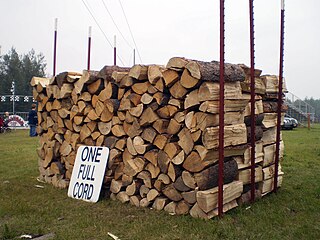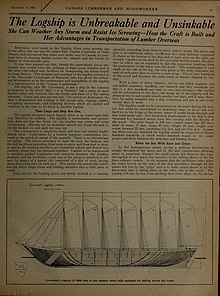
Longships were a type of specialised Scandinavian warships that have a long history in Scandinavia, with their existence being archaeologically proven and documented from at least the fourth century BC. Originally invented and used by the Norsemen for commerce, exploration, and warfare during the Viking Age, many of the longship's characteristics were adopted by other cultures, like Anglo-Saxons, and continued to influence shipbuilding for centuries.

The yard is an English unit of length in both the British imperial and US customary systems of measurement equalling 3 feet or 36 inches. Since 1959 it has been by international agreement standardized as exactly 0.9144 meter. A distance of 1,760 yards is equal to 1 mile.

Lumber is wood that has been processed into uniform and useful sizes, including beams and planks or boards. Lumber is mainly used for construction framing, as well as finishing. Lumber has many uses beyond home building. Lumber is sometimes referred to as timber as an archaic term and still in England, while in most parts of the world the term timber refers specifically to unprocessed wood fiber, such as cut logs or standing trees that have yet to be cut.

The Newport Ship is a mid-fifteenth-century sailing vessel discovered by archaeologists in June 2002 in the city of Newport, South East Wales. It was found on the west bank of the River Usk, which runs through the city centre, during the building of the Riverfront Arts Centre; from which process it sustained some damage. The official name of the vessel is now the Newport Medieval Ship, to help distinguish it from other historical vessels.

Scaffolding, also called scaffold or staging, is a temporary structure used to support a work crew and materials to aid in the construction, maintenance and repair of buildings, bridges and all other man-made structures. Scaffolds are widely used on site to get access to heights and areas that would be otherwise hard to get to. Unsafe scaffolding has the potential to result in death or serious injury. Scaffolding is also used in adapted forms for formwork and shoring, grandstand seating, concert stages, access/viewing towers, exhibition stands, ski ramps, half pipes and art projects.
The board foot or board-foot is a unit of measurement for the volume of lumber in the United States and Canada. It equals the volume of a one-foot (305 mm) length of a board, one foot wide and one inch (25.4 mm) thick.

The twenty-foot equivalent unit is an inexact unit of cargo capacity, often used for container ships and container ports. It is based on the volume of a 20-foot-long (6.1 m) intermodal container, a standard-sized metal box which can be easily transferred between different modes of transportation, such as ships, trains, and trucks.
The rod, perch, or pole is a surveyor's tool and unit of length of various historical definitions, often between approximately 3 and 8 meters. In modern US customary units it is defined as 16+1⁄2 US survey feet, equal to exactly 1⁄320 of a mile, or a quarter of a surveyor's chain, and is exactly 5.0292 meters. The rod is useful as a unit of length because integer multiples of it can form one acre of square measure (area). The 'perfect acre' is a rectangular area of 43,560 square feet, bounded by sides 660 feet long and 66 feet wide or, equivalently, 40 rods and 4 rods. An acre is therefore 160 square rods or 10 square chains.

An ice hockey rink is an ice rink that is specifically designed for ice hockey, a competitive team sport. Alternatively it is used for other sports such as broomball, ringette, rinkball, and rink bandy. It is a rectangle with rounded corners and surrounded by walls approximately 1.22 metres (48 in) high called the boards.
English units are the units of measurement used in England up to 1826, which evolved as a combination of the Anglo-Saxon and Roman systems of units. Various standards have applied to English units at different times, in different places, and for different applications.

A batten is most commonly a strip of solid material, historically wood but can also be of plastic, metal, or fiberglass. Battens are variously used in construction, sailing, and other fields.

The cord is a unit of measure of dry volume used to measure firewood and pulpwood in the United States and Canada.
This glossary of woodworking lists a number of specialized terms and concepts used in woodworking, carpentry, and related disciplines.
The hoppus cubic foot was the standard volume measurement used for timber in the British Empire and countries in the British sphere of influence before the introduction of metric units. It is still used in the hardwood trade of some countries. This volume measurement was developed to estimate what volume of a round log would be usable timber after processing, in effect attempting to ‘square’ the log and allow for waste. The hoppus ton (HT) was also a traditionally used unit of volume in British forestry. One hoppus ton is equal to 50 hoppus feet or 1.8027 cubic metres. Some shipments of tropical hardwoods, especially shipments of teak from Myanmar (Burma), are still stated in hoppus tons.

A chainsaw mill or PortaMill or Logosol sawmill is a type of sawmill incorporating a chainsaw, that is used by one or two operators to mill logs into lumber for use in furniture, construction and other uses. Although often used as a generic term, Alaskan Mill is a registered trademark of Granberg International.

The Sparrow-Hawk was a 'small pinnace' similar to the full-rigged pinnace Virginia that sailed for the English Colonies in June 1626. She is the earliest ship to participate in the first decades of English settlement in the New World to have survived to the present day.

The Covered Bridge in Cedarburg, Ozaukee County, Wisconsin, United States, is one of the last remaining covered bridges in that state, which once had about 40 covered bridges. Built in 1876 to cross Cedar Creek, the bridge is 120 feet (37 m) long and is made of pine with oak lattices. It was listed on the National Register of Historic Places in 1973 and is now used only for pedestrian traffic.

The history of the lumber industry in the united states spans from the precolonial period of British timber speculation, subsequent British colonization, and American development into the twenty-first century. Following the near eradication of domestic timber on the British Isles, the abundance of old-growth forests in the New World posed an attractive alternative to importing choice timber from the Baltic via the narrow straits and channels between Denmark and Sweden. The easily available timber proved an incredible resource to early settlers, with both domestic consumption and overseas trade fueling demand. The industry expanded rapidly as Americans logged their way across the country. In this pursuit, millions of indigenous peoples were murdered, displaced, and enslaved for the purpose of the timber industry.

American historic carpentry is the historic methods with which wooden buildings were built in what is now the United States since European settlement. A number of methods were used to form the wooden walls and the types of structural carpentry are often defined by the wall, floor, and roof construction such as log, timber framed, balloon framed, or stacked plank. Some types of historic houses are called plank houses but plank house has several meanings which are discussed below. Roofs were almost always framed with wood, sometimes with timber roof trusses. Stone and brick buildings also have some wood framing for floors, interior walls and roofs.

The Boydton and Petersburg Plank Road, also called the Boydton Plank Road, was a hard surfaced road constructed between Boydton and Petersburg, Virginia, built between 1850 and 1853. It not only increased revenues for farm products and local industries by 100%, but was also the scene of a major Civil War conflicts, such as the Battle of Boydton Plank Road and the Battle of Peebles's Farm.















